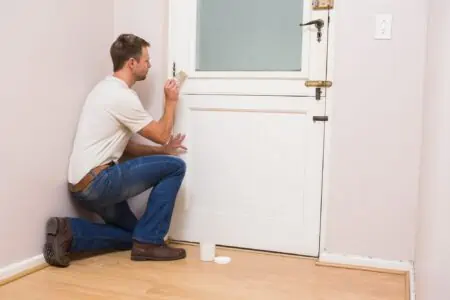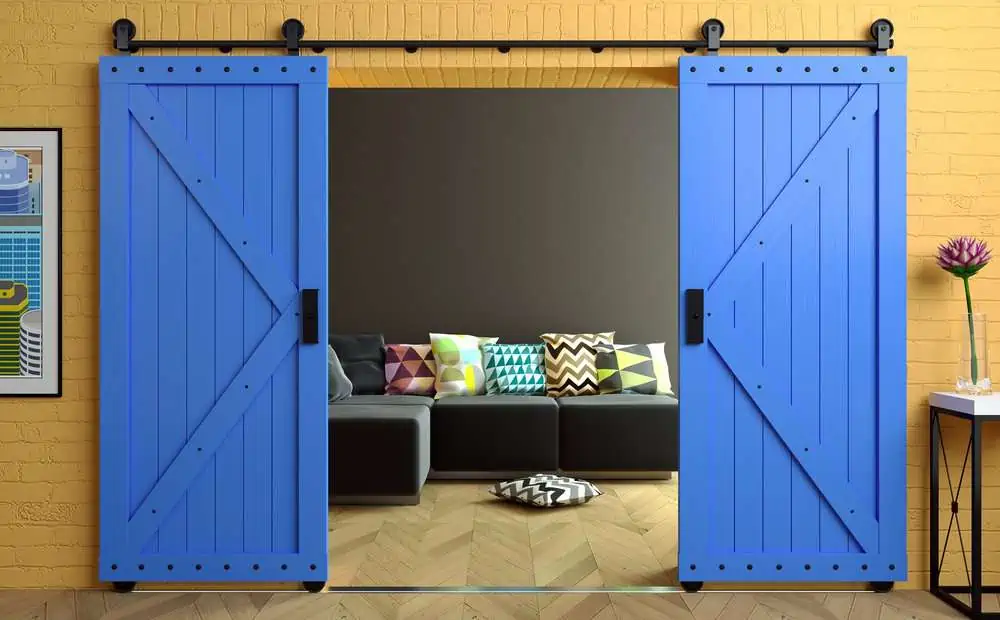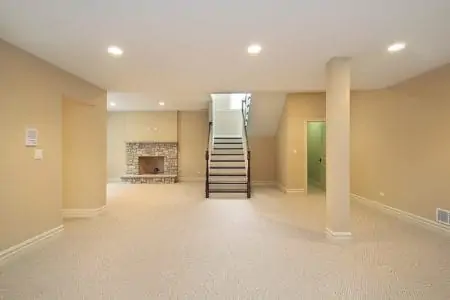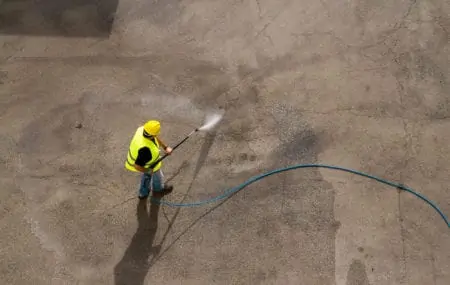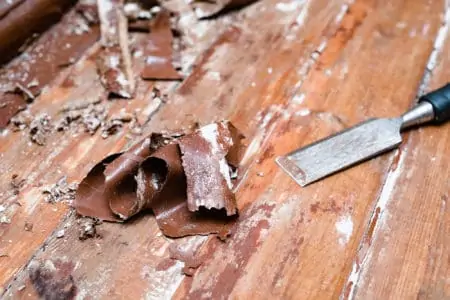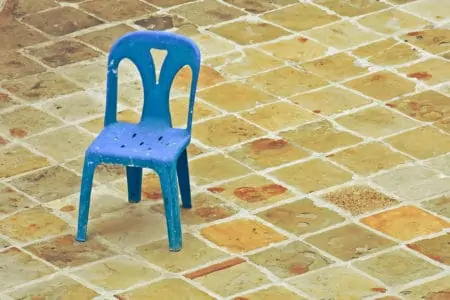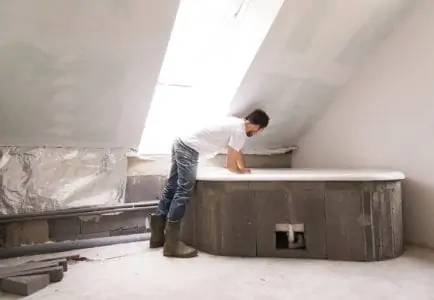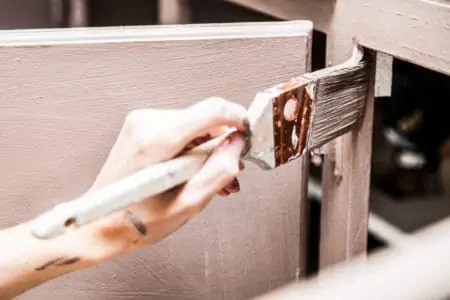Painting interior doors may seem insignificant, but flaking and patchy doors can impact the overall finish of your room. Knowing the cost of painting interior doors is crucial if you want to keep a lid on your budget.
So, how much does it cost to paint interior doors? Let’s take a look and discuss when it’s best to do the work yourself or hire a professional.
Key Takeaways
- National average cost to paint interior doors is $150, but prices vary depending on factors such as door type, paint type, and location.
- Most painters charge by the square foot, hour, or price per door: $1 to $4 per square foot, $25 to $100 per hour, or $70 to $200 per door.
- Factors affecting the cost of painting interior doors include the size and type of door, type of paint and primer, and door material.
- Additional costs to consider include repairs, permits and inspection fees, lead paint removal, and extra details such as painting door and window frames.
- How Much Does It Cost to Paint Interior Doors?
- Breakdown of Interior Door Painting Costs
- Factors Affecting Cost of Painting Interior Doors
- Additional Painting Costs
- DIY Vs. Hiring a Professional
- Average Cost to Stain Interior Doors
- How Much Paint for a Door
- Best Type of Paint for Interior Doors
- FAQs
- Final Thoughts
How Much Does It Cost to Paint Interior Doors?
The national average cost to paint interior doors is $150. However, prices vary enormously depending on several factors. Your location, the number of doors that need painting, and the type of paint you use all affect the price.
Expect to pay between $70 and $200, but you could spend as little as $50 and as much as $300.
Cost to Paint Interior Doors and Trim
There are other considerations when painting interior doors, like the cost of painting the trim. When we throw the price of painting a standard door and frame, you could easily spend upward of $200.
Let’s look in more detail:
- Standard door size and trim: $40 to $145.
- French door and trim: $150 to $200 per side.
- Door frame alone: $1 to $4 per linear foot (length, not width).
Breakdown of Interior Door Painting Costs
When calculating the price for painting interior doors, you should consider several factors. Let’s get a more detailed picture:
Labor Costs
Getting a professional to do the work is easy and convenient, but it ramps up the costs. It takes between three and five hours to paint an average door. The timescale depends on its current state of repair, the door size, and the finish.
Most painters charge by the sq ft or by the hour. You can easily spend between $1 and $4 per sq ft and $25 to $100 per hour. Some professionals quote per door, which comes in at $70 to $200.
Paint Brand
Prices vary depending on which brand you choose. Here’s a handy table to help you out:
| Brand Name | Price Per Gallon |
| Rust-Oleum | $10 to $70 |
| Kilz | $30 to $55 |
| Valspar | $10 to $60 |
| Behr | $15 to $80 |
| PPG | $25 to $85 |
| Benjamin Moore | $35 to $90 |
| Sherwin-Williams | $40 to $100 |
Primer Costs
Your topcoat is only as good as the door prep work. Primer seals the door’s surface, making it less porous. Your topcoat will cover further, giving you a better return for your money.
It also means you use fewer coats to get that super-smooth finish. Choosing a stain-blocking primer, like this KILZ Premium Primer and Sealer, protects the wood against stains and gives your paint a better surface to bond with.
Primer costs vary by type, with some costing more than others. There are several types of primer, each with specific roles. Some adhere, others seal, while some products are oil or water-based. Here’s a handy guide:
| Primer Type | Average Price Per Gallon |
| Adhesive | $15 to $60 |
| Oil-based | $20 to $50 |
| Water-based | $20 tp $80 |
| Shellac | $20 to $60 |
Keep In Mind
Oil-based primers are damaging to the environment and emit volatile organic compounds (VOCs), which contain low-level ozone.
Paint Supplies
Buying the paint and primer is one thing, but you’ll need the tools and equipment to get it on your interior doors. These costs need to be considered when calculating the final bill.
What You’ll Need
- Paintbrush: $10 to $30.
- Roller and paint tray: $15 to $30.
- Painters tape: $8 to $25.
- Drop cloths: $20 to $50.
- Sandpaper: $10 to $30
- Tack cloths: $10 to $20.
- Gloves: $4 to $15.
- Safety goggles: $5 to $20.
Factors Affecting Cost of Painting Interior Doors
Several factors affect the price you pay to paint interior doors. The type of door, the door’s size, and the door’s material impact on the costs.
Size of Door
Doors come in four standard sizes, and the size you have will impact the price.
| Door Size (Inches) | Average Cost Range (Including Labor) |
| 24 x 80 | $25 to $75 |
| 28 x 80 | $40 to $100 |
| 32 x 80 | $50 to $200 |
| 36 x 90 | $100 to $300 |
Type of Door
There are several door styles inside our homes, from bi-fold to 6-panel doors. Whichever type you have has a direct effect on the price. The costs range between $50 to $300, but the prices vary by door design.
| Door Type | Average Price Range (Labor Included) |
| Flush or flat | $50 to $100 |
| French | $200 to $300 |
| Dutch | $100 to $300 |
| 6-panel | $75 to $100 |
| Bi-fold | $70 to $100 |
| Pocket or sliding | $75 to $300 |
| Louvered | $80 to $200 |
Flush or Flat Doors
Flush doors are the simplest to paint because they are smooth, without awkward contours. They can be covered with spray paint, rollers, or brushes. It’s the reason why you only need to spend $50 to $100.
French Doors
Fre doors are typically made of wood and are larger than standard doors. They require greater prep work and take longer to paint. You will need painter’s tape to mask off the glass panels in the door to avoid splatters.
This is what takes time during preparations. These doors are also more challenging to paint without making mistakes. For several reasons, French doors are among the most expensive to paint, costing $200 to $300.
Dutch Doors
Dutch doors are also called stable doors because the top and bottom of the door can open and close independently. Typically, they are wooden in construction, which means lots of sanding and prep work. Expect to pay $100 to $300.
6-Panel Doors
These doors are traditional in style, consisting of two smaller panels at the top, two large panels in the middle, and mid-sized panels at the base. They are easy to paint, but because they are contoured, they can pose problems.
Expect to pay $75 to $100 for each door.
Bi-Fold Doors
Bi-fold doors have two panels hinged in the middle that fold back on themselves, making them great for space-saving.
Bi-fold doors can be rollered, spray painted, or brush painted, and they come in wood, composite, and aluminum frames. Expect to pay $70 to $200 per door.
Pocket or Sliding Doors
Sliding doors are ideal for opening up your space while still giving you the option to close off areas. Typically, sliding doors are wooden, like those found on old barns, so the painter must do their prep work.
They will probably use oil-based paint because it will withstand greater punishment, especially if the door is in a high-traffic area.
These doors are another space-saving design to use minimal floor space. They also come in pocket varieties, where the door retracts into a recess inside the wall. Expect to pay between $75 to $300.
Louvered Doors
Louvered doors have a slatted frontage, with wooden planks angled at 45 degrees. They can be tricky to paint because of the awkward angles, but nothing that a qualified painter couldn’t handle. They are often used on closets and cupboards and cost $80 to $200 per door.
Type of Paint and Primer
The type of paint you use affects the price. From water-based to oil-based, the product you choose behaves differently and has varying uses.
Oil-Based Paints
Oil or solvent-based paint is great for high-traffic areas. It dries rock hard, withstands scuffs and scratches, and retains its color for longer. However, oil-based paints are bad for the environment because they contain chemicals that pollute rivers and streams.
They also have high VOCs (volatile organic compounds) that emit low-level ozone when they dry. If you are using an oil-based product, like this Rust-Oleum Protective Enamel paint, be sure to open windows and doors to reduce odors.
You will also need mineral spirits, like this Klean Strip Odorless Mineral Spirits, to clean your brushes and rollers. Mineral spirits are also damaging to the environment.
Typical price range: $20 to $60 per gallon.
Water-Based Paints
Water-based paints are kinder to the environment because they wash clean with soap and water. They don’t contain the nasty chemicals associated with oil-based paints, so they don’t emit low-level ozone as the paint dries.
However, water-based paints are not as hard-wearing as solvent paints, and scuff and chip more easily. They are also not wipe-clean like oil paints.
Typical price range: $15 to $50 per gallon.
Chalk Paint
Chalk paint is flat, making it non-reflective. It covers well, with minimal coats, and dries in super fast time. Chalk paint is easily marked, so beware of using it in high-traffic areas. It is the most expensive option, but requires minimal prep work, and hides imperfections well.
If you mark your chalk paint, it won’t wipe clean, so keep that in mind. You can use chalk paint to customize your doors, and it’s great for creating that distressed look, often called shabby-chic.
Typical price range: $30 to $80.
Type of Paint Finish
The type of paint you use affects the price. It boils down to the finish. Some people prefer high-gloss, while others like matte paints like Rust-Oleum Chalk Paint.
| Paint Finish | Average Price Per Gallon |
| High-gloss | $17 to $80 |
| Semi-gloss | $12 to $70 |
| Satin | $12 to $60 |
| Eggshell | $11 to $60 |
| Matte | $10 to $70 |
High-Gloss
Gloss paint is ideal for doors, frames, and baseboards. The formula contains higher binder and resin levels, making it more robust than other paint finishes. It’s why this paint is among the most costly on the market.
You can use gloss paint in most high-traffic areas of your home. This Diamond Hard Gloss from Majic Paint is hard-wearing and protects wooden surfaces. It is also wipe-clean, so perfect for painting your bathroom or kitchen.
Semi-Gloss
As the name suggests, semi-gloss paint sits between gloss and satin. It is the best paint for interior doors because it still gives a high sheen but is less conspicuous than gloss paint. It will still highlight every scratch or scuff because of the reflective surface quality.
Semi-gloss is popular as a door and trim paint, with plenty of brand choices to meet your needs. This Behr Premium Plus is ideal because it is a paint and primer in one.
Satin
Satin paint is a great compromise because it still has wipe-clean qualities but without the high sheen of gloss or semi-gloss. You still get a reflective surface, so it bounces light into the room, but without that mirror-like finish of a gloss.
If you think satin paint will hide flaws on the door’s surface, think again. It still highlights every blemish but deals with stains better than matte paint. This Prestige Satin paint is a great option for your doors and frames.
Eggshell
If you have doors that get less use, like a bedroom or bathroom door, eggshell is the ideal choice. Using it in high-traffic locations, it will stain and scuff easier and need touching up more readily.
You still get a degree of shine, but it is far more muted than gloss or satin. This Valspar Professional Eggshell Paint is a trusted name and gives good coverage.
Matte
Matte paint has high pigment values but without resins and binders associated with gloss paint. If you want to create a flat feel, matte paint is your best option.
Using matte paint is a double-edged sword because it hides imperfections. However, it cannot handle stains and scuffs, making it unsuitable for doors in high-traffic areas. This Rust-Oleum Milk Paint is an excellent example of a matte finish available in one-quart cans.
Door Material
The material of your door affects the way the paint covers it. Some door materials are easier to coat than others.
| Door Material | Average Price Range (Including Labor) |
| Wood | $100 to $200 |
| MDF | $50 to $100 |
| Vinyl | $70 to $115 |
| Composite | $70 to $150 |
| Metal | $90 to $150 |
| Fiberglass | $150 to $300 |
Wood
Wooden doors are relatively expensive compared to other materials. Use oil-based products on wooden doors because latex paint could cause the wood grain to expand as it soaks in.
Oil-based paint is more resistant to staining and moisture and gives a more hard-wearing outer shell. You can also stain a pre-hung wooden door, which is easier than painting but more expensive.
Average price range: $100 to $200.
MDF
Medium-density fiberboard is a cheaper alternative to wooden doors. It consists of wood shavings, resin, glue, and dehydrated sawdust. Use oil-based paints because MDF hates moisture.
If you don’t have an oil-based topcoat, use an oil-based primer to seal the MDF against moisture. Then you can use whatever paint you want for the topcoat.
Average price range: $50 to $100.
Vinyl
Vinyl doors work better with water-based primers and paints. It helps the paint adhere better and dries in super-fast time. You can apply the color with a sprayer, brush, or roller, and it takes minimal prep work before the paint application.
Average price range: $70 to $115.
Composite
Composite doors are made from wood, metal, and PVC, making them stronger than other materials. If you care about security, this is the door material to use. Avoid water-based paint and stick to oil-based products.
Average price range: $70 to $150.
Metal
Metal doors consist of aluminum, iron, and steel. The painting costs are similar for each material but only use oil-based paint because it adheres better and reduces rust.
There is minimal prep work because metal is already smooth, and you get excellent paint coverage per gallon.
Average price range: $90 to $170.
Fiberglass
Use acrylic or water-based paints on fiberglass doors. You can also use epoxy or polyurethane paints, like this Varathane Polyurethane paint. These paints are less likely to blister and adhere well to fiberglass.
Word Of Caution
Don’t use oil-based paints because they will react with the fiberglass and damage the door.
Additional Painting Costs
With every project, there are additional costs to bear in mind. Knowing what they are in advance helps you keep a firm hand on the budget.
Repairs
Your door condition matters because it means the extra expense of repairing cracks and blemishes. Using filler, like this Gorilla All-Purpose Wood Filler, you can plug gaps and smooth the surface for a better finish.
Fillers are relatively inexpensive, costing between $10 and $20.
Permits and Inspection Fees
You probably won’t need a permit to paint internal doors, but check your local building code first. Inspection fees are unlikely because when the painter calls to check what work you want, they will check the quality of the doors.
Most pros charge by the hour, square foot, or price per door. Expect to pay $1.50 to $4 per square foot, $25 to $100 per hour, or $50 to $200 per door.
Lead Paint Removal
Don’t mess about with lead paint; call in the pros. Lead paint has been banned for 40 years in the USA, and the removal cost can be expensive. One way to deal with lead paint is to try the encapsulation method, which involves overpainting to seal the lead in.
If one door has lead paint, there’s a good chance that others have the same problem. This could add to your costs significantly. Lead paint removal can cost between $9,500 to $30,000, depending on the task size.
Top Tip
It may be cheaper to remove doors covered in lead paint rather than stripping the paint. However, if you have an older house, it may spoil the character of your home.
Extra Details
If you want the neatest finish, you need to factor in the cost of painting door and window frames, baseboards, and other trims. Standard doors and trim will cost $40 to $145. French doors and additional trim will cost $150 to $200, and to do the frame alone will cost $1 to $4 per linear foot.
DIY Vs. Hiring a Professional
The labor costs are the biggest difference between doing the work yourself and paying for a professional paint service. To hire a painter, you should expect labor costs of $70 to $200 per door. It costs you nothing to paint internal doors besides your time and effort.
However, you may be better off paying by the hour for smaller tasks because it could cost you less. Expect to pay $25 to $100 per hour and $1.50 to $4 per sq ft.
Keep In Mind
You make significant savings on the paint costs because a pro will bulk buy, negotiating favorable rates with their supplier. They can pass these savings onto you.
Average Cost to Stain Interior Doors
It could be an easier option if you stain your doors rather than repaint them. Staining involves less work, and your doors look new, but it can be as expensive as paint.
Staining is an excellent way of enhancing the natural wood grain and preserving the wood against daily wear and tear. Expect to pay between $50 and $180 depending on the stain type and the door material.
How Much Paint for a Door
Knowing how much paint you’ll need to paint your door is useful because it saves you on wastage costs. You’ll need to calculate the size of the door and the number of coats you’ll need.
The average internal door measures 32 inches by 80 inches, and you will be painting the front and back. A one-quart (a quarter of a gallon can) will cover both sides. Expect to pay $8 to $18, but be prepared to double this price if you need a second coat.
Best Type of Paint for Interior Doors
The best product to use on internal doors is oil-based paint. It is durable, wipes clean, withstands stains and scuffs in high-traffic areas, and is easier to maintain. Choose satin or semi-gloss paint for the best results because of the resin and binder content.
FAQs
Final Thoughts
So, there you have it, the complete rundown of how much it is to paint interior doors. If you choose to do the work yourself, all you need are the materials and tools. If you call in the pros, sit back and relax while they complete the project.
However, if money is a driving factor, it is cheaper to take the DIY approach because labor costs account for over 80 percent of your final bill.
